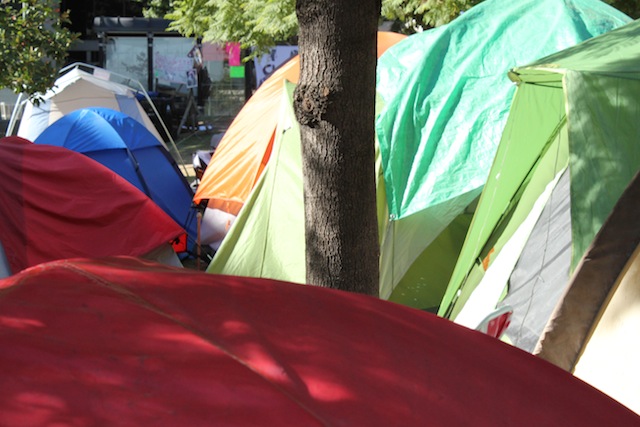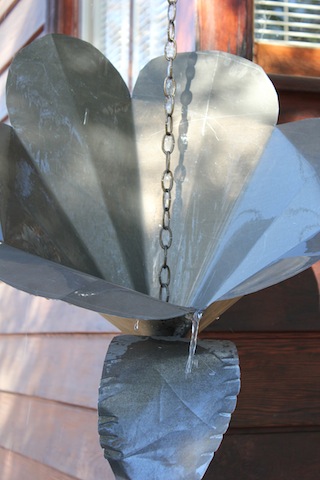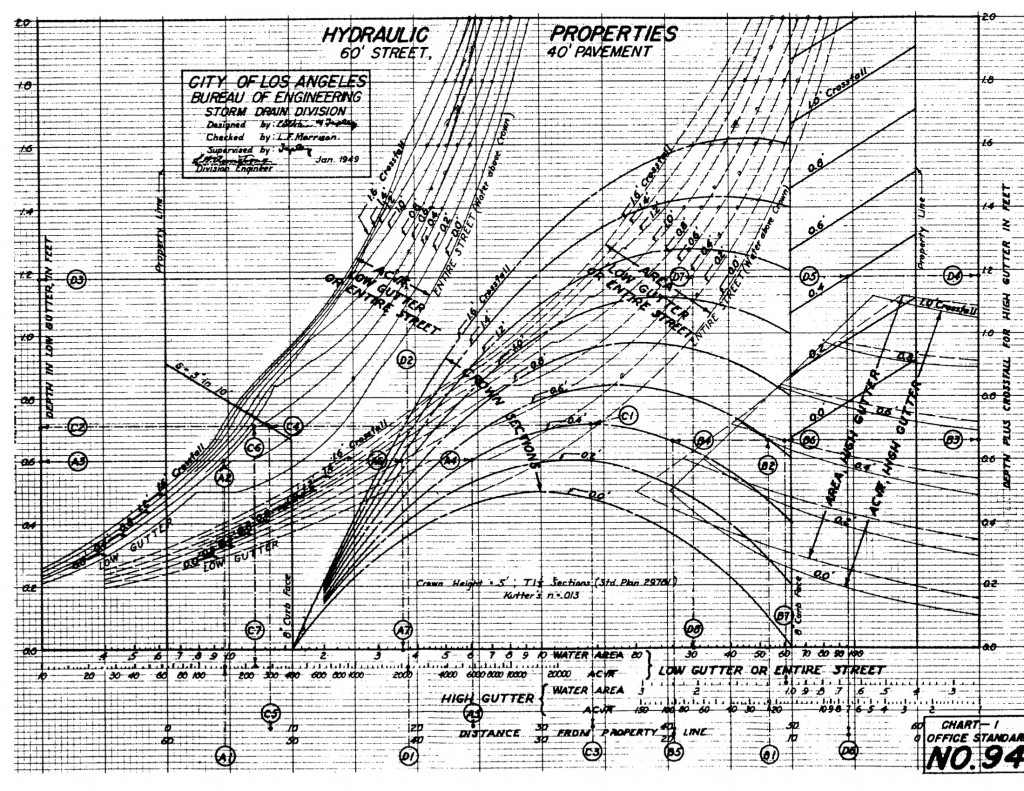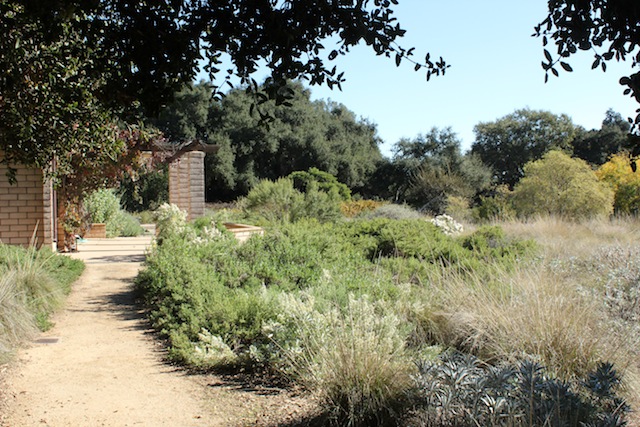Speak now or forever hold your peas
Posted on | January 5, 2012 | No Comments
 It’s a toss up as to which I like better about this Downtown News story, that the City of Los Angeles has called a public meeting to discuss plans for a landscape to replace lawn smothered by those wholly organic Occupiers, or that a reader is already making plant suggestions in the comment box. Either way, this story joins reports by KPCC and the LA Times that the Department of Rec & Parks will be weighing up the call to replace the lawn with something more befitting America’s only major metropolis with a Mediterranean climate. The meeting will be held on Tuesday, January 10th at 6.30 pm at the Los Angeles Theatre, 615 South Broadway. For background and links, there is no better source than the Mar Vista Community Council Green Committee. Click here to see a petition begun by Mar Vista activist Sherri Akers calling for a more sustainable model garden around City Hall than the wasteful old turf one so thoughtfully dispatched by Occupy. In the interest of full disclosure, I am a signer.
It’s a toss up as to which I like better about this Downtown News story, that the City of Los Angeles has called a public meeting to discuss plans for a landscape to replace lawn smothered by those wholly organic Occupiers, or that a reader is already making plant suggestions in the comment box. Either way, this story joins reports by KPCC and the LA Times that the Department of Rec & Parks will be weighing up the call to replace the lawn with something more befitting America’s only major metropolis with a Mediterranean climate. The meeting will be held on Tuesday, January 10th at 6.30 pm at the Los Angeles Theatre, 615 South Broadway. For background and links, there is no better source than the Mar Vista Community Council Green Committee. Click here to see a petition begun by Mar Vista activist Sherri Akers calling for a more sustainable model garden around City Hall than the wasteful old turf one so thoughtfully dispatched by Occupy. In the interest of full disclosure, I am a signer.
High good, low bad: Mead in 2011
Posted on | January 1, 2012 | No Comments
 When the federal Bureau of Reclamation recorded the closing elevation of Lake Mead to be almost 1,133 feet at midnight, December 31, the 2011 rise in the largest storage reservoir on the Colorado River was more than 46 feet, the first annual gain since 2005 and the largest since 1957 — so big that the decanting of last year’s snowpack has been causing a series of earthquakes in the Arizona desert. As Mead hits 56% full, and the other major storage reservoir on the Colorado, Lake Powell, sits at 66%, the bad news is that snowpack building up this year around the Colorado’s headwaters in the Rockies is significantly down, as is Northern Californian snowpack in the Sierra. Locally, rainfall is also below normal. By way of explaining the artwork, the Reclamation graphic above contrasts projected flow and demand in a river supplying roughly a third of Southern California’s water.
When the federal Bureau of Reclamation recorded the closing elevation of Lake Mead to be almost 1,133 feet at midnight, December 31, the 2011 rise in the largest storage reservoir on the Colorado River was more than 46 feet, the first annual gain since 2005 and the largest since 1957 — so big that the decanting of last year’s snowpack has been causing a series of earthquakes in the Arizona desert. As Mead hits 56% full, and the other major storage reservoir on the Colorado, Lake Powell, sits at 66%, the bad news is that snowpack building up this year around the Colorado’s headwaters in the Rockies is significantly down, as is Northern Californian snowpack in the Sierra. Locally, rainfall is also below normal. By way of explaining the artwork, the Reclamation graphic above contrasts projected flow and demand in a river supplying roughly a third of Southern California’s water.
Full metal garden
Posted on | December 23, 2011 | No Comments

To harvest rain from your roof for the garden, first you have to catch it. This requires gutters. Gutters are by no means universal appurtenances. Some home styles, such as Craftsman, Spanish and Colonial lend themselves so happily to gutters that they usually come with them. The rolled metal amounts to jewelry around the eaves.
However, put the same gutters on a modern home and you have a problem. The handsomeness of the structure is often defined by the lines of the roof and eaves. Gutters look dumpy; downspouts amount to vandalism.
The upshot? To those of us who live in midcentury homes and want to practice water conservation, the question of whether or not to put up gutters can feel like a choice between looking good or being good.
Click here to keep reading part one on capturing rain in the Los Angeles Times and here for part two.
Ruben Ruiz, the sheet metal artist and gutter fabricator described in these pieces may be reached at:
ruizsheetmetal [@] gmail.com by removing the anti-spam brackets and closing the spaces.
The Dry Garden: Engineered to fail
Posted on | December 16, 2011 | No Comments
 As the days of Occupy LA’s tenancy around City Hall Park became numbered last month, I wrote in the op-ed pages of this paper that the city should seize the opportunity to replace the trashed lawn with a model garden demonstrating state of the art storm water capture and drought tolerant planting. The Mar Vista Community Council immediately began a campaign to support it. The Sierra Club, Natural Resources Defense Council, California Native Plant Society and Theodore Payne Foundation for Wildflowers and Native Plants each wrote the Department of Recreation and Parks calling for the city to seize the opportunity. But the most forceful argument came in the one-two punch of the November 30 windstorm swiftly followed by this week’s rain.
As the days of Occupy LA’s tenancy around City Hall Park became numbered last month, I wrote in the op-ed pages of this paper that the city should seize the opportunity to replace the trashed lawn with a model garden demonstrating state of the art storm water capture and drought tolerant planting. The Mar Vista Community Council immediately began a campaign to support it. The Sierra Club, Natural Resources Defense Council, California Native Plant Society and Theodore Payne Foundation for Wildflowers and Native Plants each wrote the Department of Recreation and Parks calling for the city to seize the opportunity. But the most forceful argument came in the one-two punch of the November 30 windstorm swiftly followed by this week’s rain.
Click here to keep reading in The Dry Garden column in the Los Angeles Times about why floods follow winter windstorms and what this has to do with trees. For tips from some of the region’s leading arborists and urban foresters about how to prevent “tree failure,” click here. This piece, from late in 2006, looked at the challenges faced by the City of LA as it began its “million tree” program and the challenges of steadily renewing an aging urban canopy. Suffice it to say that the challenge of thinning over planted areas and planting barren ones have only intensified given the mixed results of the mayor’s program.
The Dry Garden: Into the tall grass, tentatively
Posted on | December 9, 2011 | No Comments

There is nothing lovelier than tall ornamental grasses, backlit and waving in a breeze. Even vacant lots can produce stands of car-crash-inducing beauty. So when gardeners hope to capture some of that lyrical action for their own homes, it’s logical to assume that all one need do is stop mowing the lawn. Alas, that would be wrong. Harnessing the tousled romance of ornamental grasses (and plants that look like these grasses) is so hard that even experienced horticulturists factor generous time and space for trial and error into their approaches before they have, in effect, allowed the right plant to do its stuff in the right place.
Click here to keep reading this week’s Dry Garden in the Los Angeles Times on landscaping with native ornamental grasses.
« go back — keep looking »


